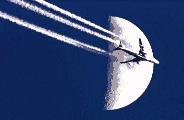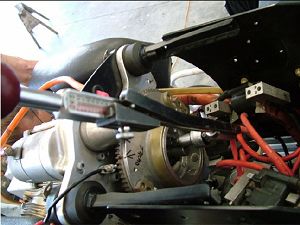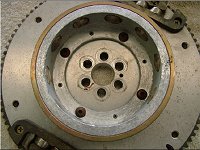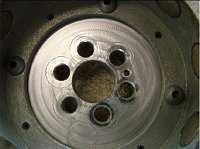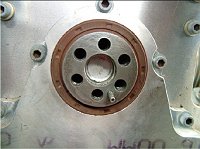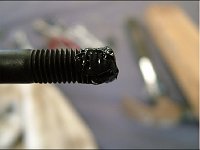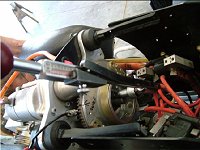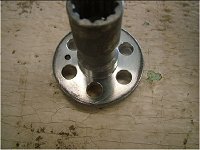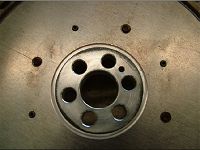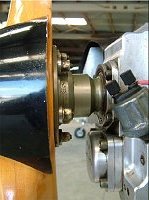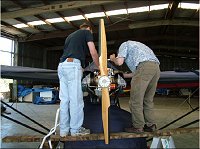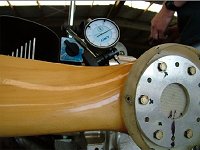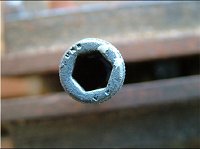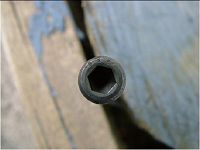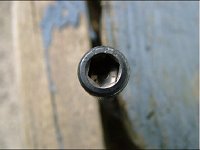Contrails ! Investigation on Three Jabiru 2200 Fly Wheel Attachments
Jabiru flywheel bolts verification
On the 3rd December 2006 three Jabiru 2200 engines had their flywheel bolts replaced and re-torqued, the following shows the process and findings.
Anton Lawrence is technical officer for the Recreational Aircraft Association of New Zealand (RAANZ). This study on flywheel bolts proper tensioning originally appeared in RAANZ' magazine Recreational Pilot - Issue #27.
This article is published here with Anton's kind permission
Anton Lawrence's article
An Investigation on Three Jabiru 2200 Fly Wheel Attachments
On the 3rd December 2006 three Jabiru 2200 engines had their flywheel bolts replaced and re-torqued, the following shows the process and findings.
The three engines were fitted to Bantam B22J aircraft, each aircraft was fitted with a standard Jabiru propeller.
The first engine was Number 22A 794 and had completed 175.2 hours

The Bantam requires the battery, starter solenoid, regulator and engine support to be removed to gain access to the stator plate.
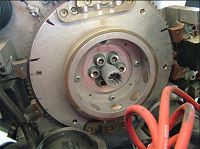
This is engine number 1677 but is the same as number 794. It was decided to remove and inspect the flywheel and vacuum drive. The black registration marks were added to ensure the ignition timing wasn’t lost.
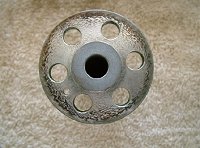
This is the back side of the vacuum drive it is pressed against the timing gear. The fretting is very obvious.
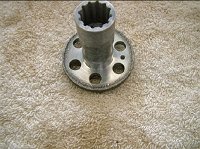
This is the side which presses against the back of the
flywheel; there is a ring of fretting here also.
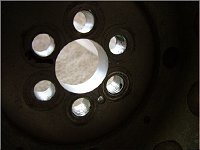
Thread marks are visible in the flywheel holes consistent with fretting. All three flywheels had these imprints.
Anton Lawrence, RAANZ Tech Officer
Engine two
Engine two was number 22A 1677 and had completed 120.6 hours
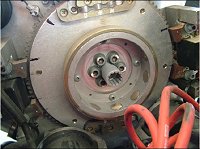
Number two flywheel, the flywheel had to be rotated 90 degrees and the mags removed to enable the flywheel to be removed.
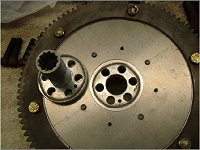
The back of the flywheel and the front of the vacuum drive also showed signs of fretting.
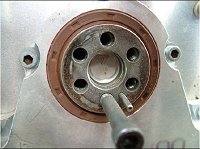
This is the part of the timing gear which protrudes the crankcase. The roll pin was factory fitted to assist in alignment. The bolt is a new one being used to clean the threads. Fret marks are clear.
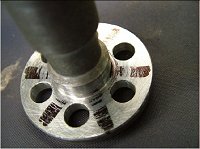
The Vacuum drive interfered with the flywheel at the internal radius. The flywheel had more chamfer removed to prevent this interference, sorry no picture.
Anton Lawrence, RAANZ Tech Officer
Engine three
Engine number three was number 22A 1614 and had completed 116.7 hours
Anton Lawrence, RAANZ Tech Officer
Propellers
The three aircraft props
Anton Lawrence, RAANZ Tech Officer
Cap screws
Anton Lawrence, RAANZ Tech Officer
Anton Lawrence's analysis
Crack off torque
We used a simple bar and long needle type torque wrench to remove the bolts, this was used in order to gauge the tightness of the restraining compound verses the clamp pressure.
Engine 1 required 12 to 15 foot pounds (ft/lb) to break the static friction (crack off) and then took about 10 ft/lb to undo out of the crank. Once the bolt disengaged from the crank it was easily removed from the three clamped components.
Engine 2 required 20 ft/lb to crack off and then 18 ft/lb to unscrew; it was easily removed once the threads had disengaged the crank.
Engine 3 required about 25 ft/lb to crack off and then 20 plus ft/lb to unscrew; it also removed easily once it had disengaged the crank.
Prop Flange Run Out and Tracking
Engine 1 0.06mm and 2mm respectively
Engine 2 0.06mm and 2mm respectively
Engine 3 0.2mm and 0mm respectively
Summary
Engine 1 clearly had less bolt torque than the other two engines, none the less engine two showed greater signs of fretting. Engine twos hours are similar to engine threes but engine three showed the least fretting.
The crack off test did not reveal the actual bolt preload but it would seem fair to conclude that engine 3
did in fact have the higher preload. Although engine one took less torque to undo the bolts it had more
running time and less fretting than engine two but more than three.
It would also be fair to conclude that the higher the preload on the bolts the less the fretting.
We removed the flywheel and the vacuum drive but not the timing gear as this would have required engine removal and rear strip down. This will be reviewed in 50 hrs.
New Hardware
I had purchased new SEP brand (owned by Brighton Best) 2 inch 5/16 socket head cap screws (SHCS). I had also purchased new 5/16” grade 8 hardened washers. The intention was to replace the thin “Belleville” type washer to better spread the load over the aluminium flywheel. On inspection it was found that the head of the SEP SHCS was 1mm smaller in diameter than the removed Unbrako brand and the washer had 1mm clearance around the bolt shaft. This added up to very little bolt resting on the washer and it was felt prudent to just reuse the existing washer. Remember to install them the correct way round (high centre out).
I have since been back to Brighton Best and discovered that the YFS brand are the same dimensions as the Unbrako brand.
Why the difference? The Unbrako and Brighton Best YFS brands are made to the 1960 specification and SEP to an older specification; this is because a lot of machinery requires the smaller head cap screw, the material is none the less of a high standard.
DON’T USE SEP CAP SCREWS OR ANY OTHER WITH THE SMALL HEAD DIAMETER
The Installation
After cleaning out the threads we decided to use “molly” grease in the threads and under the washer face of the SHCS, the higher preload attainable and the ability to re-torque the bolts made the decision easier. We first tightened the bolts to 20 Nm (this was achieved from snug tight in about 15 deg) and then attempted to take them to 40 Nm. This was impossible for two reasons. Firstly the strength of the hex wrench was not up to it and they continually self destructed at about 31 Nm, secondly I had calculated the turn of the nut to be about 50 degrees, we had gone way past that and it was evident that the aluminium parts were starting to compress under the strain.
With the grease in the thread and under the bolt head we were able to consistently torque the bolts to 30 Nm without tool damage so that’s what we did.
Theory says that with Loctite in the thread and no lube under the bolt head 30 Nm gives about 4600 Lbs of axial force through the bolt and with lube 5800 lbs, a significantly big margin. 41 Nm has been achieved on other engines, with the correct load spreading it should be possible on these engines.
The Next Inspection
In 50 hours we are obliged to do the whole process again. We will use Umbrako or YFS (Brighton Best) branded bolts and will install hardened washers (Nordlock will be considered). The flywheel will be removed to see if the fretting has been minimised or stopped completely. If the fretting has returned it may be best if the engines get dowels fitted ASAP.
Problems in design
The fact that one is trying to restrain aluminium alloy parts in a clutch like manner against steel parts with high strength fasteners is in its self a problem. The compressive strength of the aluminium is less than the steel. The load needs to be better spread or the aluminium replaced with steel. The “Belleville” washers were designed as a variation on the spring washer; they simply crush flat under the high load of these fasteners and spread the load little. Hardened washers would help to spread the load further. A hardened steel ring under the heads could also help. Dowels one would think should help prevent this fretting but it should be remembered that two of the restrained parts are aluminium alloy and could flog out around the dowels if exposed to excessive shear forces.
Currently the parts are fretting, at between 150 to 250 hours, no problems are seen, but as the fretting goes on the preload on the bolts drops off, a critical point is reached where the preload will fall to a significantly low level allowing the fretting to rise exponentially. The bolts will then become exposed to shear loads they were never designed for, they will develop flaws which propagate through the bolt on the shear line, and then as the tensile stress area becomes too small to with stand the loads, they break one by one. Sometimes the load of starting will cause the final failure and sometimes they will break in the air. Neither is satisfactory.
Bolt locking Considerations.
- Loctite.
- Advantages, easy to use, low cost per bolted unit, reasonably affective at preventing back off. Disadvantages. High undoing torque (may need heat) leaves residue in the threads which needs to be cleaned before a new bolt is fitted.
- Lock Wire.
- Advantages, easy to undo, leaves no residue in the threads.
Disadvantages, very fiddly in this application, hard to achieve proper tension. - Tab Washers.
- Would need to be purpose made in pairs and would be very hard to fix against a cylindrical head.
- Belleville and Spring Washers
- Compress flat under the high preload of these bolts making their effectiveness negligible.
- Nordlock Washers
- Advantages, Are hardened and spread the load well, can not back off as they require
a higher torque than the set torque, allow for lubrication in the thread and under the head, unlikely to
break the bolt on undoing as the restraint is under the head.
Disadvantges, are more costly than most other practical solutions, can not be ground to fit tight installations.
Conclusion
If one replaces the bolts at 50 hr intervals you will avert a disaster but one can not comment on the state of your parts as time goes on if you do not inspect them properly. S/B JSB012 instructs you not to remove the flywheel or vacuum drive as you will loose valve timing. It has been shown that it is very easy indeed to remove the flywheel and drive unit and check these surfaces. Newer engines even have a roll pin which appears to drive into the crank to ensure timing is not lost (don’t spin the prop) and locates the flywheel on re-assembly. If you do not inspect these parts properly you can have no idea of problems ahead, if these parts are badly fretted then it would be advisable to pull the engine out, remove the back cover and check the timing gear. If you leave badly fretted parts in place with out resurfacing the time before failure will be greatly shortened.
Anton Lawrence, RAANZ Tech Officer
To learn more
This article in pdf format
 Anton's article in pdf version
Anton's article in pdf version
Other bolt articles by Anton Lawrence
Anton's article on Jabiru Flywheel bolts 
Anton's article on Bolt locking devices 
Documents
 JSB012-1
JSB012-1
- Jabiru's Service Bulletin on Flywheel Attachment
 DCA/JABENG/1&2
DCA/JABENG/1&2
- CAA's AD on Jabiru 2200 & 3300 propellers and flywheel attachment
 mil-hdbk-60
mil-hdbk-60
- MIL-HDBK-60 Military handbook on threaded fasteners proper tension
 Loctite 620 (en)
Loctite 620 (en)
- Loctite 620 English technical data sheet
 Loctite 620 (fr)
Loctite 620 (fr)
- Fiche technique Loctite 620
Websites
 RAANZ
RAANZ
- RAANZ website
 Jabiru Australia
Jabiru Australia
- Jabiru Australia's website
 Loctite NZ
Loctite NZ
- Loctite NZ website
 Send an email
Send an email
